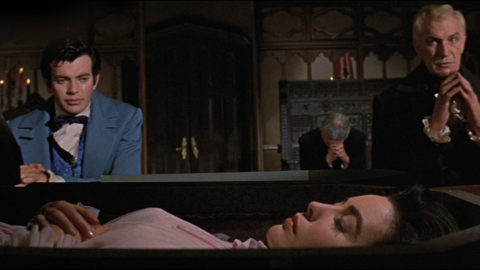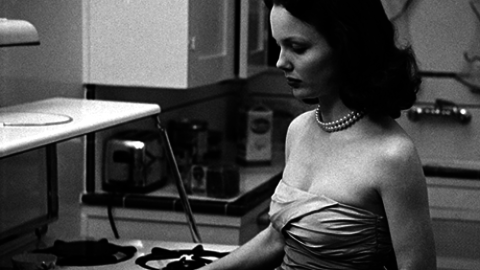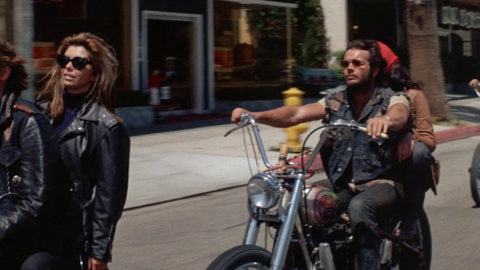Cinema ‘67 Revisited: The Born Losers, Hot Rods To Hell, and The Trip
In my 2008 book Pictures at a Revolution, I approached the dramatic changes in movie culture in the 1960s through the development, production, and reception of each of the five nominees for 1967’s Best Picture Academy Award: Bonnie and Clyde, The Graduate, In the Heat of the Night, Guess Who’s Coming to Dinner, and Doctor Dolittle. In this biweekly column, I’m revisiting 1967 from a different angle. As the masterpieces, pathbreakers, and oddities of that landmark year reach their golden anniversaries, I’ll try to offer a sense of what it might have felt like to be an avid moviegoer 50 years ago, discovering these films as they opened.
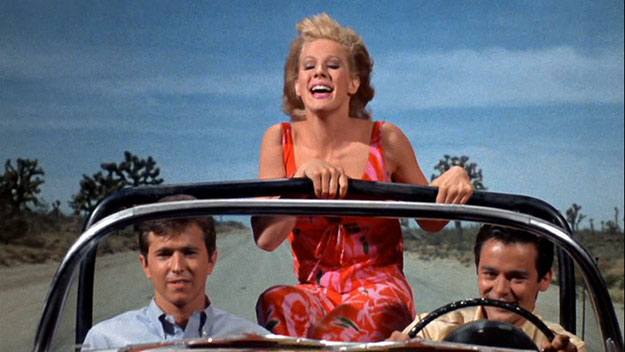
Hot Rods to Hell
In 1967, there was no such thing as “summer movie season.” Films were released throughout the year, on a Friday or Tuesday or Monday, in scattershot patterns across the country; Bonnie and Clyde opened in two Manhattan theaters on a Sunday 50 years ago this week and didn’t start making most of its money for many months. But even back then, there were movies that felt destined for the dog days before Labor Day weekend, fill-ins that theaters programmed while they waited for the next piece of (presumably) top-tier studio product. Many of those movies were fast, cheap, and lurid, and in the summer of 1967 they catered to growing cultural uneasiness about the generation gap, lawlessness, “free love,” and plentiful drugs. They were movies about “crazy” young people made by—and in part for—their nervous middle-aged parents, who were peering fearfully, but with transfixed fascination, over the edge of the abyss.
So what could you have seen to get through a sticky summer evening while waiting for Clyde to meet Bonnie or Virgil Tibbs to find himself stranded in the South? Hot Rods to Hell, from MGM, is a good example of how the studios reacted to “youth culture”; it was produced by 66-year-old Sam Katzman (who also made that year’s Riot on Sunset Strip), was directed by 72-year-old German refugee John Brahm, and starred, as was often the case, a couple of past-their-prime stalwarts, Dana Andrews and Jeanne Crain (poignantly referred to in the New York Times review as “postwar favorites”). Andrews is an all-American dad who, after a back injury, decides to restart his life by moving his family to a new town and running a motel. On the way, they encounter hot-rodders. “Maybe the police won’t think that running people off the road with those souped-up sardine cans of yours is such a joke!” Andrews barks to one young tough who threatens him at a service station. “What is it with kids today?” sighs the attendant. “You know what kind of people those kids come from? Honest, God-fearing for the most part…They work hard for a living. Nobody knows what kids want these days! Nobody in God’s creation!”
Or at studios. Hot Rods to Hell, with its record-settingly awful process shots, its performance of “Do the Chicken Walk” by “Mickey Rooney, Jr., and His Combo,” and its already dated acting (poor Crain, with a hairdo like waxed fruit, is both embalmed and over-emotive), would have been laughed off the screen by any real teenager, especially when Andrews’s daughter (Mimsy Farmer) starts throwing smoky looks at the wild rebels from the back seat (“They were draggin’, Dad!”). It’s not a movie about rebellion but about generational terror. Seven years later, Death Wish would take the material this film plays with—rape leading to parental vigilantism—to its fullest and ugliest conclusion. Hot Rods to Hell stays on somewhat safer ground, since everything it wants to show is wildly beyond what a studio in 1967, pre-Bonnie and Clyde, could get away with.
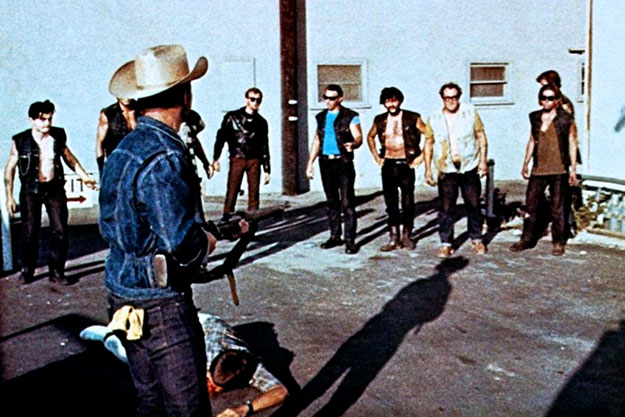
The Born Losers
Indies were freer to step over the line, and Born Losers did. This was the first of the Billy Jack movies, the brainchild of producer/director/actor Tom Laughlin, and one of the most baffling and inexplicable of all oddball film series. Like Hot Rods to Hell, Born Losers is about a town menaced by a gang of bad guys (in this case, acid-dropping cyclists with swastikas on their jackets), and it also features one relic of Old Hollywood, unkindly identified by Times critic Howard Thompson as “a battered-looking Jane Russell.” But the focus was firmly on Billy Jack, the Native American hero. Laughlin did a hasty, on-trend voiceover rewrite to make him a Vietnam veteran, one of the first to be referenced in an American movie, and conceived him as a kind of left-wing fascist pacifist vigilante. If you think that doesn’t quite track, you’re correct, but there’s no law that says an exploitation movie’s internal politics have to be coherent (Laughlin’s certainly weren’t; he later ran for President as both a Democrat and a Republican).
In Born Losers, it’s a rape (heard but not shown) that sparks the vengeance, complete with the victim trying to stave off a more brutal attack by remarking, “You know the old saying—if rape is inevitable, relax and enjoy it!” “Groovy saying!” the bikers reply. The movie, which is, if you haven’t already guessed, well-nigh unwatchable, serves as a reminder that sexual politics in American movies lagged a decade or more behind the loosening of content standards, as exemplified by the scene in which one young woman decides she’s not going to testify against the rapists because . . . she liked it. One should, perhaps, be grateful that Laughlin never got around to making his planned two-part finale to the series, which was to be entitled Billy Jack’s Moral Revolution.
To revisit exploitation movies from the mid-1960s is to have the hope of ironic fun almost consistently thwarted by grim reality. They’re mostly parties you want to leave after about 15 minutes. Even the genre’s grandmaster, Roger Corman, couldn’t entirely get his bearings. The year 1967 was a peculiar one for Corman, who, for the first time, planted a foot in the respectable mainstream while keeping the other rooted in the kind of low-budget fringe filmmaking on which his reputation still stands. Nearing the end of his career as a director (though as a producer he’s still going after 63 years, 411 credits, and one honorary Oscar), he directed one movie for American International Pictures, The Trip, and one for 20th Century Fox, The St. Valentine’s Day Massacre. The latter remains the sole major studio movie of his career (and it isn’t exploitation, just a heavy-handed period gangster melodrama about Al Capone, played by a miscast Jason Robards, Jr., that is of historical interest only because it opened in New York four days before Bonnie and Clyde reinvented the entire genre).
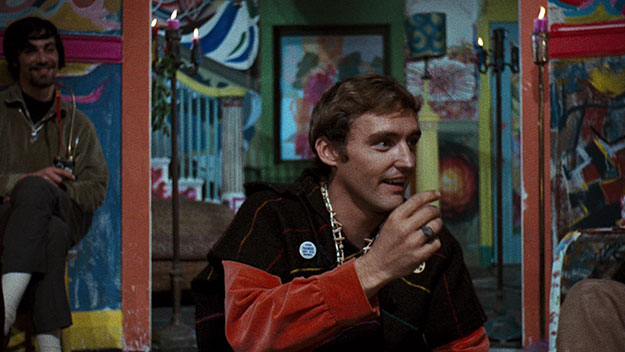
The Trip
Corman was more assured on his home turf. The Trip is best remembered as a kind of warm-up for Easy Rider, which would arrive two years later: Peter Fonda stars and Jack Nicholson wrote the script. At 79 minutes, it goes by quickly—it’s really not much more than a canny filmmaker’s attempt to suck some dollars out of the public’s fascination with LSD. Corman, always shrewd, gave a press conference in New York at which he explained that he himself had dropped acid “under strict medical supervision for research”; if that wasn’t enough to attract the curious, the movie (the poster for which promised “a big thrill in a little pill”) also featured nudity, which was still rare enough that it drew a well-publicized condemnation from the National Catholic Office for Motion Pictures.
But The Trip is cautionary right from its stern prologue crawl telling moviegoers that they’re about to be exposed to “a shocking commentary on a prevalent trend of our time…that must be of great concern to all.” Then we meet Fonda, a director of TV commercials (“Lies!”) who’s hanging out with buddy Bruce Dern and ready, under the supervision of experienced tripper Dennis Hopper, “to find out something about myself.” What follows is what you’d imagine: cheap kaleidoscope effects, not-quite-subliminal-enough flash cuts, projections on writhing bodies, revelers in flouncy peasant shirts . . . medieval hooded figures on horses in the woods . . . a costumed gnome stirring a cauldron . . . okay, maybe you didn’t see that one coming, but The Trip never lets you linger too long in inner space without a Dragnet-style jolt back to reality. “A guy in Frisco taking that stuff?” says one young woman. “He walked through a window and killed himself!”
The Trip cost about $400,000 and grossed 20 times that, suggesting that a reasonable portion of its audience walked out convinced that they’d had exactly the theme-park ride into psychedelia that they’d hoped they would. Although Fonda’s character seems to emerge from his experience unscathed, AIP, over the objections of Corman, Fonda, and Nicholson, insisted on imposing a shattered-glass visual and sound effect over a freeze-frame of his face in the movie’s last shot, to suggest that his final line—a blithe “I’ll think about that tomorrow”—is the product of a mind that doesn’t even know it’s destroyed. It was a victory for the trepidatious over the adventuresome—one of the last at a moment when that balance was about to tilt thrillingly in the other direction.
How to see them: All three movies stream on Amazon and other streaming services and are available on DVD.
Mark Harris is the author of Pictures at a Revolution: Five Movies and the Birth of the New Hollywood (2008) and Five Came Back (2014).



